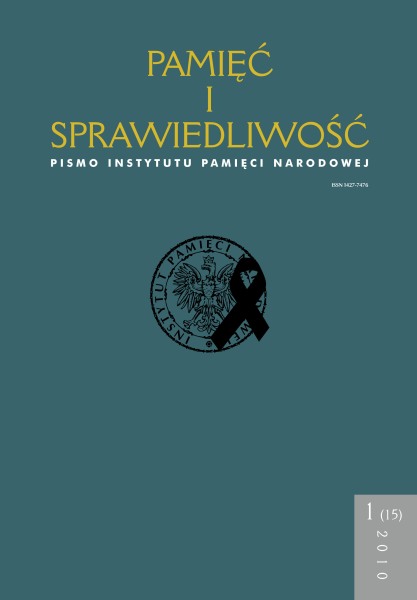The Activity of the Chief Civil Commissioner in September 1939
Remembrance and Justice, Vol. 15 No. 1 (2010), pages: 233-252
Publication date: 2010-06-30
Abstract
The institution of the Chief Civil Commissioner by the Commander in Chief was appointed on 1 September 1939. Its aim was to provide proper functioning of the direct background of the front. This attitude was taken by the voivode of the Polesie Region, Wacław Kostek-Biernacki. Although the works concerning the actions of a similar unit were initiated at the beginning of the thirties, since the beginning of the war, the unit struggled with problems of organisational, logistic and personnel nature. In this connection, and also because of a very unfavourable course of war for the Polish side, the unit’s activity had an improvisatorial
character. One may distinguish three periods of activity. The first was between 1–6 of September in Warsaw. At that time, the main issues to cope with were, above all, the organisational and legal preparations of the Chief Civil Commissioner Office to function efficiently. Signs of its activity consistent with the assumed
aims of its existence were not found. Another period is the stay in Brest between 7–11 September. Only then a relatively ordered activity was developed. W. Kostek-Biernacki issued a regulation on the settlement of issues connected with masses of refugees, with fights against diversion and with reconstruction of roads. He won an increase in Polish State Police authority in relation to the army. The necessity to leave Brest by the Commander in Chief ’s staff caused also the departure of the staff of the Chief Civil Commissioner Office. On 16 September, the regulation reached Kolomyia, passing Vladimir-Volynsky, Lutsk and Tarnopol. During the evacuation, after leaving Vladimir-Volynsky, a temporary breach of relations with the Commander in Chief ’s staff occurred. At that time, W. Kostek-Biernacki interfered in the issues connected with the members of the Organisation of Ukrainian
Nationalists (OUN) who were in prisons in the Tarnopol Region. Then, a conflict with the authorities of the Tarnopol Voivodship took place. Prime Minister Składkowski and probably the Commander in Chief were informed about the conflict. On 17 September, he issued an order for Leon Kniaziołucki to fill the post of the chief commissioner. This nomination had no practical meaning because of Soviet aggression. Information about it probably did not reach the personnel of the Chief Civil Commissioner Office. In view of leaving Poland, W. Kostek-Biernacki dissolved the Office and crossed the Polish-Romanian border.
Most read articles by the same author(s)
- Piotr Cichoracki, Accused Second Republic. Communist Repressions Against Voivodes of the Interwar Period , Remembrance and Justice: Vol. 38 No. 2 (2021)
- Piotr Cichoracki, Aleksander Ilin, Przyczynek do dziejów komunistów w 1939 r. Dwa rękopisy Romana Zambrowskiego , Remembrance and Justice: Vol. 23 No. 1 (2014)
- Piotr Cichoracki, Jerzy R. Prochwicz, [Recenzja] Jerzy R. Prochwicz, Formacje Korpusu Ochrony Pogranicza w 1939 roku, Wydawnictwo Neriton, Warszawa 2003, ss. 458 , Remembrance and Justice: Vol. 8 No. 2 (2005)
- Piotr Cichoracki, Paweł Duber, [Recenzja] Piotr Cichoracki, Droga ku anatemie. Wacław Kostek-Biernacki (1884–1957), Instytut Pamięci Narodowej, Warszawa 2009 , Remembrance and Justice: Vol. 17 No. 1 (2011)
- Mieczysław Adamczyk, Janusz Gmitruk, Piotr Cichoracki, [Recenzja] Sprawcy klęski wrześniowej przed sądem historii, red. Mieczysław Adamczyk, Janusz Gmitruk, Oficyna Wydawnicza ASPRA-JR, Muzeum Historii Polskiego Ruchu Ludowego, Wszechnica Świętokrzyska, Warszawa 2005, ss. 317 , Remembrance and Justice: Vol. 10 No. 2 (2006)
- Piotr Cichoracki, Niezrealizowana koncepcja osądzenia Wacława Kostka-Biernackiego , Remembrance and Justice: Vol. 8 No. 2 (2005)
 Język Polski
Język Polski
 English
English
 Deutsch
Deutsch
 Français (France)
Français (France)
 Italiano
Italiano
 Русский
Русский


 PDF (Język Polski)
PDF (Język Polski)
